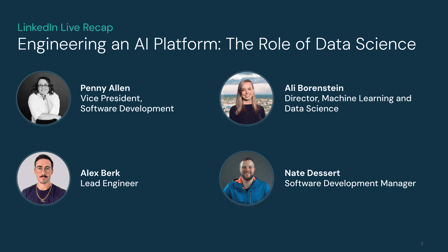LinkedIn Live Recap: The Role of Data Science in Building an AI Platform

Yesterday, I got the chance to share how some of my incredible engineering and data science teammates — Ali, Nate, and Alex — are thinking about something we're all passionate about: the intersection of engineering and data science and how we're using it to enhance Shipium’s platform.
For those who missed it, here's a recap of our discussion and the insights we shared.
Data Science is the Bedrock of AI
One of the key points we explored, led by our Head of Data Science, Ali Borenstein, is that you can’t have AI without building a foundation in data science, and you can't have data science without a strong data infrastructure.
At Shipium, we’ve been building this foundation for years — it’s been at the core of our platform since the beginning. For example, our proprietary transit model is trained on the millions of shipments executed via the Shipium platform. This provides us with a massive, rich dataset that allows our models to make incredibly precise predictions and decisions. This deep historical data is the bedrock that allows us to move fast and build powerful AI capabilities that solve real, complex problems.
How AI Builds on our Modeling
Alex Berk, our lead engineer, then walked us through a compelling demo that showed how we're bringing our models to life. While our models have been working behind the scenes for years, we’re working on creating new and more intuitive ways to interact with them.
To that end, we’re building a conversational AI that acts as a sort of "human-in-the-loop" interface for operators. Once this tool is rolled out to our customers, they’ll be able to ask natural language questions and get immediate answers about their shipping operations.
For instance, Alex showed how we could ask why a particular shipment was routed a certain way, or why a more expensive option was chosen. In one example, a shipment to a PO box in Alaska was sent via USPS Priority Mail instead of a cheaper option. The AI explained that our model, trained on historical data, prioritized on-time delivery over selecting the lowest-cost option. That’s because our transit modeling predicted that the cheaper option might be a day or two late, prompting the selection of a slightly more expensive carrier to ensure the delivery promise made to a customer was met.
This is the power of our data and models — we’re able to help shippers account for real-world conditions, rather than using static criteria. The AI tool allows users to easily access and understand the insights generated by our models by having a natural conversation.
The Future: Your AI Supply Chain Partner
Nate Dessert, one of our development managers, then shared his vision for the future of AI in shipping. We're not just building a chatbot; we're building a true partner for operators.
Imagine a future where you can work side-by-side with an AI to manage your supply chain. You could ask it to analyze your carrier mix, suggest changes, and even help you navigate complex carrier tasks like managing your response to holiday surcharges or general rate increases. As mentioned above, this AI companion would leverage our foundational models and rich data to provide real-time, actionable insights that help you make better, faster decisions.
This is the direction we're headed, and it's only possible because of the incredible collaboration between our data science and engineering teams. We're working together to build a robust, intelligent platform that not only presents you with data but also gives you the tools to act on it.
Wrapping Up
This is just the beginning of our journey, and we're excited to be building in public, sharing our progress, and gathering feedback along the way. We believe the intersection of engineering and data science is the key to unlocking the future of shipping, and we invite you to come along for the ride.
Stay tuned for our next LinkedIn Live, where we’ll continue to explore how we're building the next generation of Shipium’s platform.
And if you missed it, here’s a link to the session.

Penny is Shipium's Vice President of Software Development, leading our engineering team in the development of our platform.

